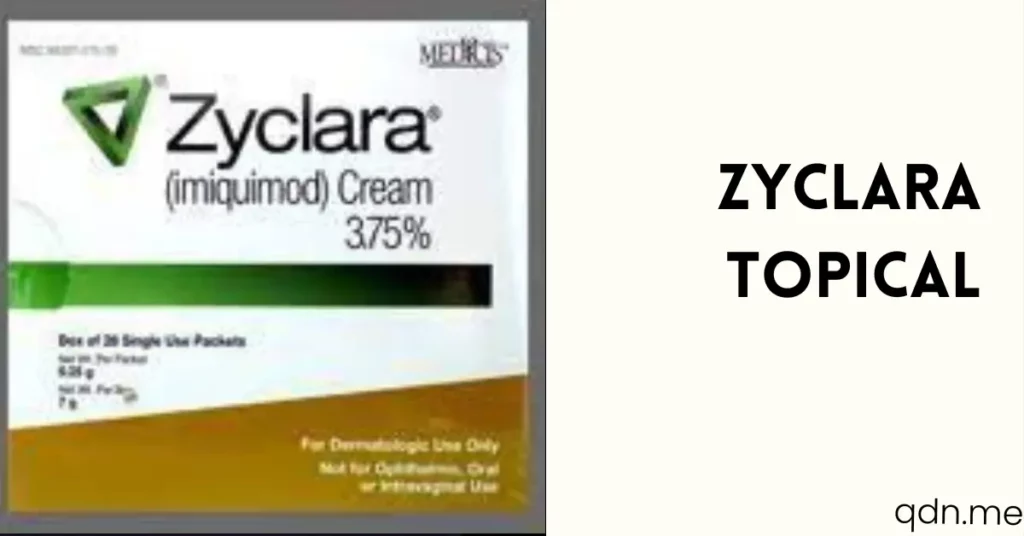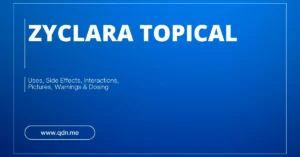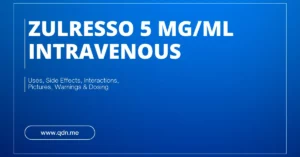Zyclara Topical: Uses, Side Effects, Interactions, Pictures, Warnings & Dosing

Zyclara Topical is a medication that helps in the treatment of actinic keratosis, a type of skin growth caused by exposure to sunlight. It has immunomodulatory properties that activate your immune system and destroy the affected skin cells. In this blog post, we will discuss everything you need to know about Zyclara Topical. We will cover its uses, potential benefits, side effects, interactions, and precautions to take before starting treatment with it. We have also included a visual guide that includes images of the packaging and dosing instructions with pictures. This guide will help you ensure that you are using Zyclara Topical correctly and getting the most out of its benefits while minimizing any risks associated with its use.
Understanding Zyclara Topical
Zyclara topical cream effectively treats actinic keratoses by modulating the immune response in the treatment area. It is crucial to use Zyclara cream precisely as instructed by the physician, applying it only to the affected skin area. Adhering to the prescribed application time and dosage is vital for the cream to have the desired therapeutic effect. The mechanism of action of Zyclara cream involves enhancing the immune response in the target tissue, thereby effectively treating actinic keratoses. Physicians provide specific instructions for the application of Zyclara cream, emphasizing the importance of following these guidelines strictly. Using the cream solely on the affected skin area ensures targeted treatment while minimizing potential side effects. Patients need to adhere to the prescribed application schedule and dosage to derive the maximum benefit from Zyclara cream.
What is Zyclara Topical?
Zyclara cream, a prescription medication, is used to treat precancerous growths and new skin growths caused by sun exposure. It activates the immune system to target the affected area. Not intended for skin cancer or warts. Avoid use in children under 12 years old.
The Role of Zyclara Topical as an Immunomodulator
Zyclara cream works to regulate the immune system response at the treatment site, aiding in the identification and elimination of abnormal skin growths. Due to the immune response, the cream may lead to skin reactions and should not be applied to severely inflamed or broken skin. It is crucial to avoid sun exposure while using Zyclara cream to prevent adverse reactions. This topical immunomodulator plays a vital role in assisting the immune system in targeting and addressing specific skin concerns, contributing to its effectiveness in treatment.
Uses of Zyclara Topical
Zyclara cream is prescribed for the treatment of actinic keratoses, which are precancerous growths on the skin. When using Zyclara cream, it should be applied once daily to the affected area of the skin. It is important to only use Zyclara cream on the face and balding scalp and to avoid its application near the eyes, nostrils, and mouth. The continuous use of Zyclara cream is essential for the prescribed treatment period. This approach ensures that the cream is optimally effective in treating actinic keratoses without missing doses or interrupting the treatment regimen.
How to Use Zyclara Topical Effectively
Using Zyclara cream requires adherence to specific guidelines for optimal results. Before application, it’s essential to cleanse the treatment area with mild soap and water. Once dry, apply a thin layer of the cream to the affected skin and gently rub it in. After application, ensure immediate hand washing unless the hands are in the treated area itself. It’s important not to cover the treated skin with bandages, dressings, or other products, and also to avoid contact with the eyes, nostrils, mouth, and genitals. These steps are crucial for the safe and effective use of Zyclara cream.
Potential Benefits of Zyclara Topical
Zyclara cream offers the advantage of treating precancerous growths on the skin, reducing the risk of skin cancer development, and promoting the immune response against abnormal skin growths. Following the stipulated directions for usage can result in an improved appearance of the treated area. Additionally, the cream may effectively prevent the formation of new unusual skin growths.
Side Effects of Zyclara Topical
Zyclara cream may lead to skin reactions, such as redness and flaking. Some individuals might experience itching, burning, and pain at the application site. The mild side effects of the cream generally improve within a few weeks of treatment. It is vital to discuss potential side effects with the healthcare provider. Seek medical assistance if severe skin reactions, sores, or fluid-filled blisters occur.
Common Side Effects and How to Manage Them
Experiencing skin reactions and pain are the most common side effects of using Zyclara cream. To manage mild side effects, consider incorporating a rest period during the treatment, which can help alleviate discomfort. It’s crucial to minimize sun exposure and diligently apply sunscreens as recommended to prevent exacerbation of the side effects. Additionally, utilizing non-medicated skin products and maintaining cleanliness in the treated area may provide relief from the side effects. Should you encounter difficulties in managing skin reactions or side effects, consulting your healthcare provider is advised for personalized advice and support.
Serious Side Effects and When to Seek Medical Attention
Serious side effects, including severe dizziness and difficulty breathing, should prompt immediate medical attention. It’s crucial to seek medical help for symptoms of a serious allergic reaction and report any new unusual skin growths or changes in the treated skin area to the doctor. For severe skin reactions, such as hardening of the skin, it is important to consult a healthcare professional promptly. If experiencing complications or very serious allergic reactions, seeking medical advice promptly is essential.
Interactions with Zyclara Topical
Informing your healthcare provider about any existing drug interactions is crucial. Zyclara cream may interact with nonprescription drugs and herbal products, so it’s essential to discuss the use of Zyclara cream with your doctor if a new packet of cream is prescribed. It is advised not to use partly used packets of medication or apply the cream outside of the genitals. Proper disposal of Zyclara cream and medical waste should be carried out as per the doctor’s advice.
Drug Interactions to Be Aware Of
Understanding potential drug interactions with Zyclara cream is crucial to ensure the safety and efficacy of the treatment. It’s important to discuss any interactions with nonprescription drugs with a healthcare professional before starting the use of Zyclara. Additionally, informing your doctor about any herbal products and drugs you are taking is essential, as it will help in assessing the risk of complications from possible drug interactions with Zyclara topical cream. Moreover, being aware of the potential interactions between Zyclara cream and other topical medications is necessary for the successful management of the treatment. Consulting a healthcare provider to ensure there are no potential drug interactions will help mitigate any risks associated with the use of Zyclara cream.
Interaction with Vitamins and Supplements
Interaction with Vitamins and Supplements should be carefully considered when using Zyclara topical. Understanding the risk of side effects from interactions between Zyclara topical and vitamins or supplements is crucial for the safe and effective use of this medication. It’s important to discuss the use of vitamins and supplements during Zyclara treatment with a healthcare professional to ensure that they do not interfere with the medication’s intended effects. Patients should be aware of the possible interactions between Zyclara topical and specific vitamins or supplements. Certain vitamins and supplements may impact the immune response to Zyclara cream, affecting its efficacy and safety. Consulting a healthcare provider is essential to ensure the safe use of vitamins and supplements alongside Zyclara topical, as they have the potential to either enhance or hinder the medication’s benefits. Maintaining an open dialogue with a healthcare professional about the use of vitamins and supplements while undergoing Zyclara treatment is necessary for optimizing the therapeutic outcomes and minimizing the risk of adverse effects.
Precautions with Zyclara Topical
During the treatment with Zyclara cream, it is crucial to adhere to the prescribed application time and avoid excessive sun exposure to minimize the risk of adverse reactions. Being mindful of the possibility of skin color changes and skin reactions in the treatment area is essential while using Zyclara topical. It is important to understand that the treatment area may experience the formation of sores and abnormal skin growths as reactions to Zyclara cream. Following the rest period advised by a healthcare professional is necessary to reduce the risk of complications associated with Zyclara topical. Additionally, being aware of the potential side effects and possible complications while using Zyclara cream is vital for an effective and safe treatment regimen.
Precautions Before Starting Treatment
Before initiating treatment with Zyclara cream, it is important to consider the potential risk of severe dizziness and muscle aches. Discussing the likelihood of complications and side effects with a healthcare professional is crucial before using Zyclara topical. Understanding the possible serious side effects and allergic reactions associated with Zyclara cream is essential to make an informed decision about the treatment. Being aware of the potential health risks and side effects linked to Zyclara topical cream can help in taking necessary precautions. Additionally, considering the risk of very serious allergic reactions and difficulty in breathing before starting the treatment is imperative for overall safety and well-being.
Precautions During Treatment
During treatment with Zyclara cream, it is crucial to comprehend the potential symptoms of a serious allergic reaction and affected area reactions. Staying vigilant and being aware of the possible immune response and effects on the immune system are essential precautions to take during Zyclara treatment. Adhering to the prescribed application time and allowing for adequate rest periods can significantly minimize treatment area reactions associated with Zyclara topical. Regular monitoring of the treated skin and affected areas for any new growth or precancerous developments is imperative to ensure timely intervention and care. Additionally, maintaining proper hydration by drinking plenty of water is recommended to reduce the risk of side effects and potential complications during the use of Zyclara treatment.
Understanding Overdose
Knowing the potential risks of overdose and its impact on the treated area with Zyclara cream is crucial. Understanding the possible symptoms of overdose and the potential for serious complications with Zyclara topical is essential for safe usage. Recognizing the risk of adverse effects and severe reactions associated with an overdose of Zyclara cream is important to mitigate potential harm. Being mindful of the risk of complications and side effects from an overdose of Zyclara topical cream can help prevent any untoward incidents. It’s imperative to understand the importance of seeking immediate medical help in case of a suspected Zyclara cream overdose to ensure prompt and appropriate care.
Symptoms of Overdose
Recognizing a Zyclara cream overdose is crucial to prevent serious complications. Symptoms may manifest as skin reactions and changes in skin color, indicating an excessive application. Severe dizziness and muscle aches can also indicate an overdose, highlighting the importance of adhering to the prescribed dosage. Furthermore, being aware of symptoms associated with serious allergic reactions and affected area responses is essential for timely intervention. Overdosing may also lead to abnormal skin growth and precancerous developments, emphasizing the need for cautious and precise application. Understanding these symptoms can prompt appropriate action in case of an overdose, potentially mitigating adverse effects and ensuring the safety of the individual.
What to Do in Case of Overdose
In the event of a Zyclara cream overdose, seeking immediate medical advice and attention is crucial. It’s important to follow the recommended steps for seeking medical help, which may include contacting a healthcare provider or local waste disposal company for guidance on handling the overdose situation. Understanding the importance of timely medical intervention and being prepared to provide information on the amount and time of application of Zyclara cream are also key factors in managing an overdose situation. Additionally, being aware of possible drug interactions and the patient information leaflet can help address a Zyclara topical overdose.
Visual Guide of Zyclara Topical
Viewing the labeled images of Zyclara topical packaging helps in understanding the prescribed application time and dosage instructions. These visual guides familiarize users with the proper storage and handling of Zyclara cream, ensuring safe and accurate application. By identifying the packaging and labeling through these visual aids, individuals can recognize the correct application area and treatment instructions without missing a dose or compromising the regular time for application. The visual guide also assists in recognizing the next dose and day for application, maximizing the benefits while minimizing the risk of possible drug interactions. Moreover, the clear images provide clarity on the lymph nodes affected by human papillomavirus, which is essential when using Zyclara topical, a member of the group of drugs known as immunomodulators.
Images of Zyclara Topical Packaging
Explore the visual representations of the Zyclara cream packaging to comprehend the recommended treatment area and application instructions. Acquaint yourself with the packaging and correct usage of Zyclara topical cream through visual aids that facilitate a comprehensive understanding. Identify the images of Zyclara topical packaging to ensure the safe and accurate application of the cream, promoting adherence to the prescribed guidelines. Utilize the visual references of Zyclara cream packaging to recognize the designated application time and treatment area, ensuring precise and effective application. Gain insights into the application instructions and precautions of Zyclara topical cream based on the provided images, fostering informed and responsible usage.
Dosing Instructions with Pictures
When using Zyclara Topical, it’s important to adhere to your doctor’s guidance for usage. Apply a thin layer of the cream to the affected area once daily before bedtime, following the prescribed instructions diligently. After applying the cream, remember to wash your hands thoroughly to prevent unintentional contact with other skin areas or mucous membranes. Monitoring and reporting any potential side effects to your doctor is crucial for ensuring the safe and effective use of the medication. As you continue with the treatment, it’s essential to stick to the regular time and dosage as recommended by your healthcare provider. This consistency helps in maximizing the benefits of the medication and minimizing the risk of missed doses. Additionally, be mindful of possible drug interactions and always inform your doctor about any changes in your medical history or if you are taking any other medications.
Are You Using Zyclara Topical Correctly?
When using Zyclara Topical, it’s important to follow your doctor’s instructions. Apply it once a day before bedtime to the affected area. Remember to wash your hands and avoid touching the treated area. If you experience severe side effects or don’t see improvement, consult your healthcare provider.
Frequently Asked Questions
What is Zyclara Topical used for?
Zyclara Topical is prescribed for actinic keratosis, a skin growth caused by sun damage. It stimulates the immune system to target and eliminate abnormal cells. Apply only to affected areas, not healthy skin. Possible side effects include redness, itching, and swelling at the application site.
What are some common side effects of using Zyclara Topical?
Common side effects of using Zyclara Topical may include redness, itching, and flaking at the application site. Some people may also experience pain, swelling, or blisters. If you have severe or persistent side effects, it is important to seek medical attention. Be cautious when applying Zyclara near your eyes, nostrils, or mouth.
Are there any medications or supplements that can interact with Zyclara Topical?
Potential drug interactions and supplements should be discussed with your healthcare provider before using Zyclara Topical. Certain medications, such as corticosteroids and immunosuppressants, may interact with this topical treatment. Your healthcare provider can guide you on necessary precautions and adjustments to your medication regimen. Always adhere to prescribed dosing instructions and consult your healthcare provider if you experience any adverse effects or concerns.
How should I properly apply and dose Zyclara Topical?
To properly apply and dose Zyclara Topical, start by washing and drying the affected area. Then, apply a thin layer of the medication only to the affected area. It is recommended to use Zyclara once a day, preferably at bedtime, for up to 2 weeks. Remember to consult with a healthcare professional before starting treatment.
Conclusion
In conclusion, it is important to understand the uses, side effects, interactions, dosing, and precautions associated with Zyclara Topical. This immunomodulator plays a vital role in treating certain skin conditions. To ensure its effectiveness and minimize potential risks, follow the prescribed dosage instructions and be aware of any drug interactions or precautions. If you experience any common side effects, consult your healthcare provider for guidance on managing them. It is crucial to be aware of any serious side effects and seek medical attention if necessary. Remember to always use Zyclara Topical correctly by referring to the visual guide provided, including images of the packaging and dosing instructions.



